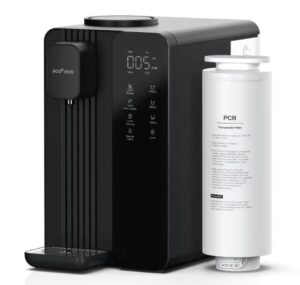Is Reverse Osmosis Water Safe to Drink? Debunking Common Myths
Reverse osmosis (RO) water filtration is a highly effective method of removing contaminants and providing clean drinking water. Reverse osmosis water filters for homes are now increasingly available. Despite its growing popularity, many people do not know enough about RO systems, so they still have misconceptions about the safety and quality of RO water. In this blog, we will address these issues and debunk common misconceptions to help you make an informed decision.
Myth 1: RO water lacks essential minerals
Fact:
RO systems do remove most minerals from water, but the minerals removed (such as calcium and magnesium) are usually too small to make a significant impact on your daily intake. Most essential minerals come from food, not water. For those who prefer mineralized water, healthy minerals can be added back into the water.
Myth 2: RO water is too acidic and unhealthy
Fact:
RO water may have a slightly lower pH because it removes alkaline minerals, but this is not harmful to health. Many beverages (such as coffee and tea) have similar acidic properties and are widely consumed without adverse health effects. If you are concerned about an unbalanced pH, you can add a remineralizer or use a filtration system like the Ecoviva MATE4 (which provides balanced water) to help maintain an optimal pH.
Myth 3: Long-term drinking of RO water can cause health problems
Truth:
RO water does not contain harmful contaminants such as heavy metals, chlorine, pesticides, and bacteria. This makes it safer than unfiltered tap water in many areas. There is no scientific evidence to support the concern that RO water will “demineralize” the body. Instead, the purity of RO water allows your body to process water efficiently without adding impurities.
Myth 4: RO systems waste too much water
Truth:
While RO systems do produce some wastewater, technological advances have greatly reduced wastewater. Most RO systems now produce much less wastewater than they do today. For example, the Ecoviva MATE4 RO system has an impressive 3:1 pure water to wastewater ratio, which is both environmentally friendly and efficient.
Myth 5: RO water tastes bland
Fact:
Many people believe that RO water tastes clean and fresh because it does not contain chlorine, fluoride, and other impurities that affect the taste. But the fact is that many RO systems now add coconut shell ingredients to the filter cartridge, which greatly improves the taste and mouthfeel of the water. It tastes very delicious. Of course, if you miss natural minerals, modern systems with remineralizing filters can add a subtle and pleasant mineral taste to your water.
Benefits of Reverse Osmosis Water Filter
Superior Filtration: Removes up to 99% of contaminants, including lead, arsenic, and microplastics.
Better Taste and Odor: Eliminates chlorine and other chemicals, improving the overall quality of water.
Customizable Options: Modern RO systems (such as Ecoviva’s countertop filter) allow users to customize water to specific preferences, including temperature and mineral content.

Conclusion: Safe, Pure, Reliable
Reverse osmosis water is not only safe, but also one of the most effective ways to ensure clean, contaminant-free water replenishment. By debunking these common misconceptions, it is clear that RO systems provide a practical, environmentally friendly and health-conscious solution for families. If you’re looking for a reliable system, consider Ecoviva’s line of countertop and under-sink filters designed to provide high-quality water with ease.
